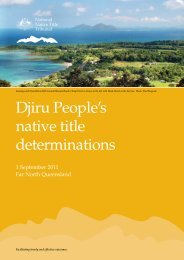Biodiveristy_State of Environment report - Mission Beach Cassowaries
Biodiveristy_State of Environment report - Mission Beach Cassowaries
Biodiveristy_State of Environment report - Mission Beach Cassowaries
- No tags were found...
Create successful ePaper yourself
Turn your PDF publications into a flip-book with our unique Google optimized e-Paper software.
ResponsesIn 1999 the Flatback turtle was listed as 'vulnerable' and theOlive Ridley turtle's listing increased to 'endangered' underthe Endangered Species Protection Act 1992.Some turtle hunting is allowed within the GBR, but it canonly be carried out by Indigenous peoples holding anappropriate permit. Even with a permit, hunting is notallowed in preservation zones <strong>of</strong> the Marine Park(GBRMPA 2005b).The fishing industry is introducing turtle exclusion devicesto trawling nets, and have guidelines for releasing turtlescaught in nets.QPWS marine <strong>of</strong>ficers will be dealing with marinestranding in the Shire, including turtles.The Federal Department <strong>of</strong> <strong>Environment</strong> and Heritage(DEH) has drafted the <strong>report</strong> "Sustainable and legalIndigenous harvest <strong>of</strong> Marine Turtles and Dugongs inAustralia - A national approach". Comments applicable arethe same as for dugongs above.Estuarine CrocodilesEstuarine crocodiles (Crocodylus porosus) are a highpr<strong>of</strong>ile species where they occur in Queensland. Theybenefit the region through tourism, and are an importantpart <strong>of</strong> the natural environment as predators at the top end<strong>of</strong> the aquatic food chain. No freshwater crocodiles arepresent in the Shire.PressureCrocodile populations face pressure from three concerns:• The availability <strong>of</strong> nesting habitat• Crocodile management tends to target the largeranimals, which are the breeders• Human activities can cause crocodiles to adopt problembehaviour which targets them for removalConditionDespite these pressures the population is breeding and therehas been some small expansion <strong>of</strong> crocodiles into areas inwhich they have not been seen for a long time. Althoughthe species is listed as 'vulnerable' there is presently nosignificant likelihood <strong>of</strong> extinction (Read, pers comm.).Crocodiles are removed by QPWS when they create aproblem for people.Crocodile sightings and removals have not varied greatlyover the last four years, though 2004 was an exciting yearwith a number <strong>of</strong> crocodiles sighted during movementsalong the coast, and one found within a stinger net.Table 3.2.2 - Number <strong>of</strong> crocodiles sightings andremoval from within the ShireSource: JSCYear Sightings <strong>report</strong>ed Removal2000 - 32001 20 32002 16 62003 13 42004 22 1Note: Not all sightings are <strong>report</strong>edEstuarine crocodile - crocodylus porosusSource:WTMAThere is still some pressure from public perception <strong>of</strong>crocodiles as a risk, though killing them is now illegal. Whilstestuarine crocodiles are the most aggressive in the world, since1985 to 2005 there have been a total <strong>of</strong> 14 attacks, and onlyfour fatalities. Of these few incidents, almost all have involvedalcohol, or swimming in a crocodile inhabited river.Comparatively, more people have been killed in altercationsThe results <strong>of</strong> radio tracking research in 2003 by QPWSindicate that crocodiles have extensive ranges along a river,and along the coast; including excursions to other riversystems. This dispels the traditional view that crocodilesare limited to defined territories. Crocodiles in the studymoved through one another's foraging ranges daily (Read,pers comm.).Also, crocodiles displaced to other river systems provedable to navigate long stretches <strong>of</strong> coastline to return to theiroriginal home. One crocodile under study returned from theGulf to its home on the east coast. All translocatedcrocodiles studied returned home.Some unusual results <strong>of</strong> the tracking showed crocodiletravelling hundreds <strong>of</strong> kilometres along the coast to visitother river systems, and then to return home. Themotivation for this behaviour is not yet understood.Potentially it is <strong>of</strong> benefit for maintaining genetic exchangeand breeding success. Considering the crocodile race hasbeen around since the time <strong>of</strong> the dinosaurs, it is likely thatthe species will show mechanisms that prevent promotegenetic exchanges and prevent inbreeding.ResponseQPWS manage crocodiles in the Shire, with communitystakeholder input through the Shire's Crocodile63



